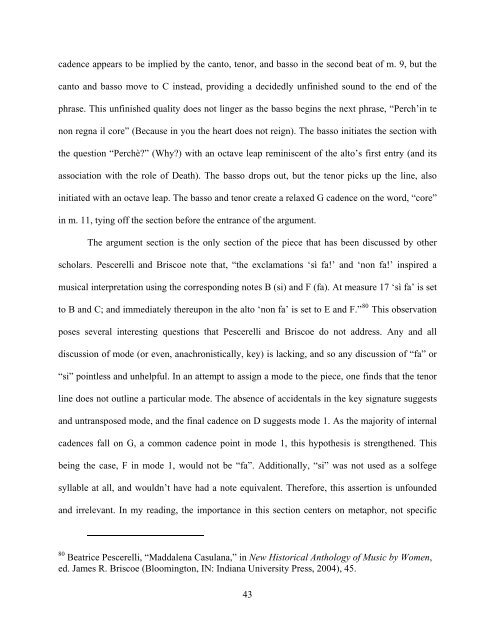Download - D-Scholarship@Pitt - University of Pittsburgh
Download - D-Scholarship@Pitt - University of Pittsburgh
Download - D-Scholarship@Pitt - University of Pittsburgh
You also want an ePaper? Increase the reach of your titles
YUMPU automatically turns print PDFs into web optimized ePapers that Google loves.
cadence appears to be implied by the canto, tenor, and basso in the second beat <strong>of</strong> m. 9, but the<br />
canto and basso move to C instead, providing a decidedly unfinished sound to the end <strong>of</strong> the<br />
phrase. This unfinished quality does not linger as the basso begins the next phrase, “Perch’in te<br />
non regna il core” (Because in you the heart does not reign). The basso initiates the section with<br />
the question “Perchè?” (Why?) with an octave leap reminiscent <strong>of</strong> the alto’s first entry (and its<br />
association with the role <strong>of</strong> Death). The basso drops out, but the tenor picks up the line, also<br />
initiated with an octave leap. The basso and tenor create a relaxed G cadence on the word, “core”<br />
in m. 11, tying <strong>of</strong>f the section before the entrance <strong>of</strong> the argument.<br />
The argument section is the only section <strong>of</strong> the piece that has been discussed by other<br />
scholars. Pescerelli and Briscoe note that, “the exclamations ‘sì fa!’ and ‘non fa!’ inspired a<br />
musical interpretation using the corresponding notes B (si) and F (fa). At measure 17 ‘sì fa’ is set<br />
to B and C; and immediately thereupon in the alto ‘non fa’ is set to E and F.” 80 This observation<br />
poses several interesting questions that Pescerelli and Briscoe do not address. Any and all<br />
discussion <strong>of</strong> mode (or even, anachronistically, key) is lacking, and so any discussion <strong>of</strong> “fa” or<br />
“si” pointless and unhelpful. In an attempt to assign a mode to the piece, one finds that the tenor<br />
line does not outline a particular mode. The absence <strong>of</strong> accidentals in the key signature suggests<br />
and untransposed mode, and the final cadence on D suggests mode 1. As the majority <strong>of</strong> internal<br />
cadences fall on G, a common cadence point in mode 1, this hypothesis is strengthened. This<br />
being the case, F in mode 1, would not be “fa”. Additionally, “si” was not used as a solfege<br />
syllable at all, and wouldn’t have had a note equivalent. Therefore, this assertion is unfounded<br />
and irrelevant. In my reading, the importance in this section centers on metaphor, not specific<br />
80 Beatrice Pescerelli, “Maddalena Casulana,” in New Historical Anthology <strong>of</strong> Music by Women,<br />
ed. James R. Briscoe (Bloomington, IN: Indiana <strong>University</strong> Press, 2004), 45.<br />
43















